Deformation Analysis and Optimization of Steel-Tube-Columns Combined-with-Bailey-Beams Doorway Support
Abstract
:1. Introduction
2. Materials and Methods
2.1. Project Overview
2.2. Finite Element Modeling
2.2.1. Sections and Material Properties
2.2.2. Loads and Boundary Conditions
2.2.3. Analytical Methods
3. Results
3.1. Deformation under Vertical Loading
3.2. Deformation under Transverse Horizontal Loading
3.3. Deformation under Longitudinal Horizontal Loading
3.4. Deformation of the Structure under the Combined Action of Three Loads
4. Discussion
5. Conclusions
- The deformation of the combined doorway support in the elastic phase satisfies the principle of superposition, which can be combined with the geometric relationship between the parts, to calculate the deformation of the combined doorway under the joint action of multiple loads;
- When subjected to vertical load, the deformation of the combined doorway is mainly caused by the deflection of the Bailey beams sheet; when subjected to transverse horizontal load, it is caused by the rotation of the foundation; and when subjected to longitudinal horizontal load, it is caused by the offset bending of the Bailey beams out of the plane;
- Selection of strengthened beams or increasing the number of transition beams can effectively reduce the vertical deformation and increase the width of the foundation, which can significantly reduce the transverse horizontal deformation; increasing the longitudinal diagonal bracing between the Bailey beams can reduce the longitudinal horizontal deformation.
Author Contributions
Funding
Data Availability Statement
Conflicts of Interest
References
- Jesus, A.M.D.; Silva, A.L.D.; Figueiredo, M.V.; Correia, J.A.; Ribeiro, A.S.; Fernandes, A.A. Strain-life and crack propagation fatigue data from several Portuguese old metallic riveted bridges. Eng. Fail. Anal. 2011, 18, 148–163. [Google Scholar] [CrossRef]
- Kowal, M.; Szala, M. Diagnosis of the microstructural and mechanical properties of over century-old steel railway bridge components. Eng. Fail. Anal. 2020, 110, 104447. [Google Scholar] [CrossRef]
- Sun, J.; Zhang, J.; Huang, W.; Zhu, L.; Liu, Y.; Yang, J. Investigation and finite element simulation analysis on collapse accident of Heyuan Dongjiang Bridge. Eng. Fail. Anal. 2020, 115, 104655. [Google Scholar] [CrossRef]
- Xu, X.; Wang, J.; Wei, J.; Taciroglu, E.; Dai, F.; Peng, W. A forensic investigation of the Taihe arch bridge collapse. Eng. Struct. 2018, 176, 881–891. [Google Scholar] [CrossRef]
- Hou, W.; Liang, S.; Zhang, T.; Ma, T.; Han, Y. Low-Carbon Emission Demolition of an Existing Urban Bridge Based on SPMT Technology and Full Procedure Monitoring. Buildings 2023, 13, 1379. [Google Scholar] [CrossRef]
- Abudayyeh, O.; Sawhney, A.; El-Bibany, H.; Buchanan, D. Concrete Bridge Demolition Methods and Equipment. J. Bridge Eng. 1998, 3, 117–125. [Google Scholar] [CrossRef]
- Zhang, Y.; Li, J.Q.; Luo, Z.Z.; Zhang, Y.Y. Design and Construction of Long Span Gateway Opening for Cast-In-Situ Box Girder of Urban Viaduct. Bridge Constr. 2012, 42, 144–147. [Google Scholar]
- Hui, S.; Xinhuan, J.; Junfeng, Z.; Zengke, G.; Jie, L.; Wei, L.; Chengshi, Z. Analysis of Support System and Construction Scheme of Precast and Assembled Viaduct Over Existing Framing Bridge. Eng. Constr. 2022, 36, 153–157. [Google Scholar]
- Mingming, C. Comparative Analysis of Calculation Methods for Bailey Beam Structure. North. Commun. 2022, 7, 22–25. [Google Scholar]
- Zhijing, G.; Jiandong, Z.; Xiaonan, F.; Duo, L. Application of Socket Type Disk Buckling Steel Tubular Scaffold in Bridge Engineering. J. Highw. Transp. Res. Dev. 2018, 35, 76–81. [Google Scholar]
- Xian, G.; Guohua, T. Study on Mechanical Behavior of Steel-concrete Composite Girders Constructed by Suspension Bracing Method. J. Highw. Transp. Res. Dev. 2022, 39, 84–90. [Google Scholar]
- Hui, S.; Huawei, L.; Xinyang, G.; Wei, J. Researches on the Mechanical Properties and Deformation Characteristics of the Temporary Support Svstem of Pile Foundation Underpinning. Build. Struct. 2021, 51, 51. [Google Scholar]
- Xuguang, Y. Construction Scheme Comparison and Selection between New Combined Truss Girder and Bailey Beam. Railw. Eng. 2018, 58, 34–38. [Google Scholar]
- Hongtao, X.; Guozhong, G.; Huanling, P.; Min, Y. Causes and Lessons of Bridge Accidents in China in Resent Years. China Saf. Sci. J. 2007, 11, 90–95. [Google Scholar]
- Aydin, A.C.; Özkaya, S.G. The finite element analysis of collapse loads of single-spanned historic masonry arch bridges (Ordu, Sarpdere Bridge). Eng. Fail. Anal. 2018, 84, 131–138. [Google Scholar] [CrossRef]
- Wang, Q.; Xian, J.; Xiao, J.; Wang, X. Intelligent safety assessment method for demolition construction of closure segment of long-span continuous rigid frame bridges. Adv. Bridge Eng. 2023, 4, 9. [Google Scholar] [CrossRef]
- Pirskawetz, S.M.; Schmidt, S. Detection of wire breaks in prestressed concrete bridges by Acoustic Emission analysis. Dev. Built Environ. 2023, 14, 100151. [Google Scholar] [CrossRef]
- Xie, C.; Li, M.; Huang, H.; Ren, Y. Numerical simulation study on the influence of impact drilling construction on the demolition of longitudinal beams on both sides of adjacent frame bridge. In Proceedings of the Sixth International Conference on Traffic Engineering and Transportation System (ICTETS 2022), Guangzhou, China, 23–25 September 2022; Volume 12591, pp. 621–627. [Google Scholar] [CrossRef]
- Pan, P.; Chen, W.; Wu, P. Safety and Stability Analysis of Demolition and Reconstruction of Existing Railway Bridge Piers and Caps. Appl. Sci. 2023, 13, 7213. [Google Scholar] [CrossRef]
- Pejović, J.; Serdar, N.; Pejović, R. Damage assessment of road bridges caused by extreme streamflow in Montenegro: Reconstruction and structural upgrading. Buildings 2022, 12, 810. [Google Scholar] [CrossRef]
- Gao, H.; Li, B.; Jian, J.; Yu, T.; Liu, H. Integral jacking of concrete continuous box beam bridge. Structures 2023, 54, 1026–1045. [Google Scholar] [CrossRef]
- Rayegani, A.; Nouri, G. Seismic collapse probability and life cycle cost assessment of isolated structures subjected to pounding with smart hybrid isolation system using a modified fuzzy based controller. Structures 2022, 44, 30–41. [Google Scholar] [CrossRef]
- Rayegani, A.; Nouri, G. Application of smart dampers for prevention of seismic pounding in isolated structures subjected to near-fault earthquakes. J. Earthq. Eng. 2022, 26, 4069–4084. [Google Scholar] [CrossRef]
- Fu, M.; Liang, Y.; Feng, Q.; Wu, B.; Tang, G. Research on the application of multi-source data analysis for bridge safety monitoring in the reconstruction and demolition process. Buildings 2022, 12, 1195. [Google Scholar] [CrossRef]
- Jiang, C.; Xiong, W.; Wang, Z.; Cai, C.; Yang, J. Transverse Connectivity and Durability Evaluation of Hollow Slab Bridges Using Surface Damage and Neural Networks: Field Test Investigation. Appl. Sci. 2023, 13, 4851. [Google Scholar] [CrossRef]
- Entezami, A.; Sarmadi, H.; Behkamal, B. Long-term health monitoring of concrete and steel bridges under large and missing data by unsupervised meta learning. Eng. Struct. 2023, 279, 115616. [Google Scholar] [CrossRef]
- Giglioni, V.; Venanzi, I.; Poggioni, V.; Milani, A.; Ubertini, F. Autoencoders for unsupervised real-time bridge health assessment. Comput.-Aided Civ. Infrastruct. Eng. 2023, 38, 959–974. [Google Scholar] [CrossRef]
- Boonkanit, P.; Suthiluck, K. Developing a Decision-Making Support System for a Smart Construction and Demolition Waste Transition to a Circular Economy. Sustainability 2023, 15, 9672. [Google Scholar] [CrossRef]
- Jiangfan, W.; Wei, Z. Comparison and Analysis of Structure Form of Steel Tubular Columns and Bailey Beam Arch Combination. Highway 2015, 60, 80–85. [Google Scholar]
- Tao, L.; Jinjing, H. Comparative Analysis on Construction Schemes Crossing Existing Railway Portal Pier. China Saf. Sci. J. 2019, 29, 69–73. [Google Scholar]
- Xueming, L.; Shizhong, L. Construction Technology and Design Calculation of Steel Tube Column-Bailey Beam Supporting System. Railw. Eng. 2016, 9, 43–46. [Google Scholar]
- Nouri, G.; Rayegani, A.; Lavasani, H.H.; Tavakoli, L.; Nasiri, M.; Soureshjani, O.K. Seismic performance of the RBS connection with trapezoidal corrugated web (TCW-RBS). Structures 2023, 56, 105003. [Google Scholar] [CrossRef]
- E, D.X.; He, H.H.; Liu, X.Y.; Ning, R.X. Spring-back deformation in tube bending. Int. J. Miner. Metall. Mater. 2009, 16, 177–183. [Google Scholar] [CrossRef]
- Wang, Z.; Du, K.; Xie, Y.; Su, X.; Shi, Y.; Li, X.; Liu, T. Buckling analysis of an innovative type of steel-concrete composite support in tunnels. J. Constr. Steel Res. 2021, 179, 106503. [Google Scholar] [CrossRef]
- Sun, X.F.; Fang, X.S.; Guan, L.T. Mechanics of Materials; Higher Education Press: Beijing, China, 2022; pp. 158–168. [Google Scholar]
- Department, Z.P.C. Bridge Support Safety Construction Manual; China Communication Press: Beijing, China, 2011; pp. 24–28. [Google Scholar]
- Xinge, D. Suspension Assembly Construction Technology for Middle Beam of Tied Arch Bridge With Hambly System. Railw. Constr. Technol. 2018, 11, 55–58. [Google Scholar]
- Xinge, D. Design and Construction on Cast-In-Place Bracket of End Floor Beam of Tied Archbridge Based on Dumbbell Type Bearing Platform Foundation. Railw. Constr. Technol. 2018, 12, 45–48. [Google Scholar]
- Shaojin, H. Multi-Purpose Manual for Assembled Highway Steel Bridges; China Communication Press: Beijing, China, 2011; pp. 21–44. [Google Scholar]
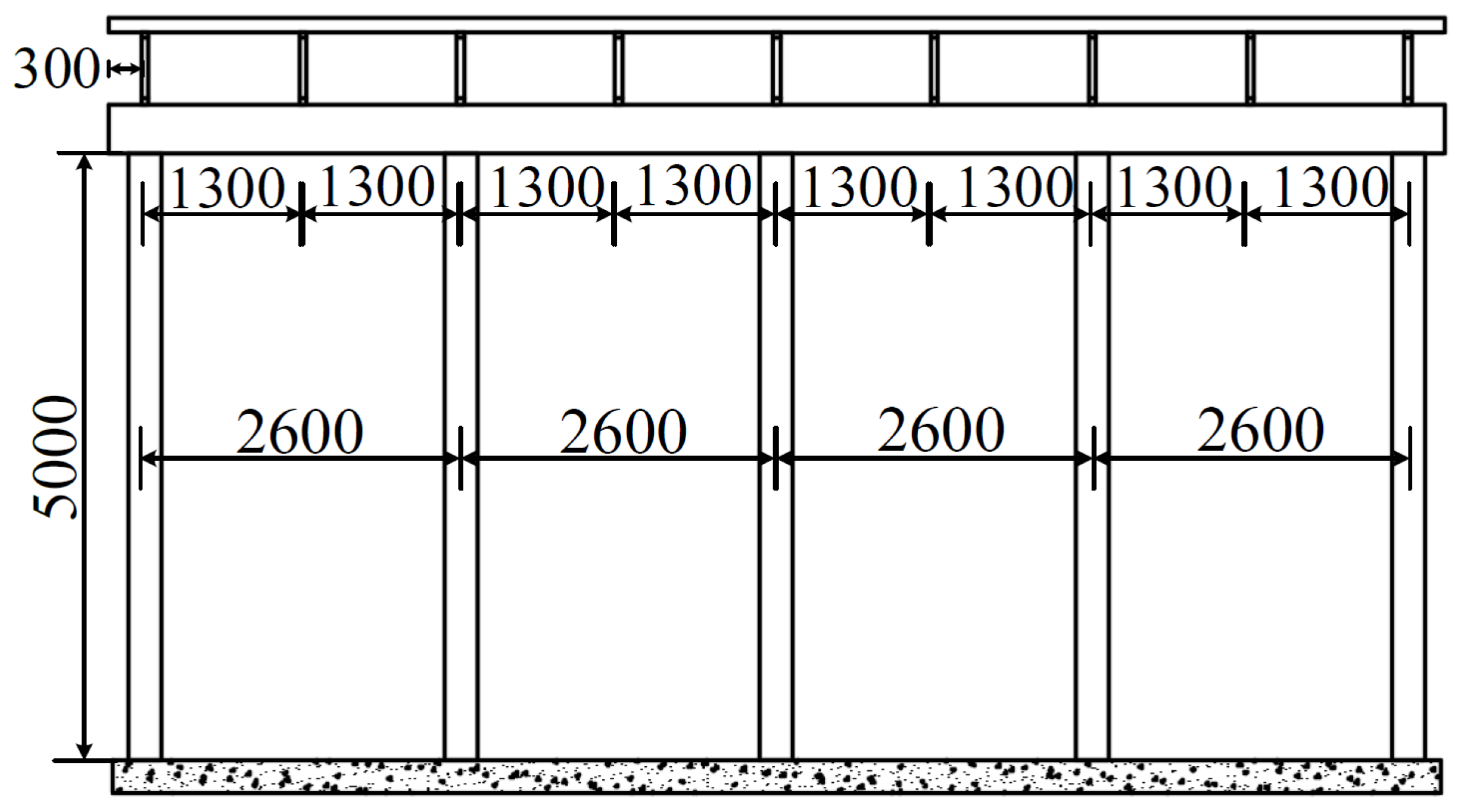



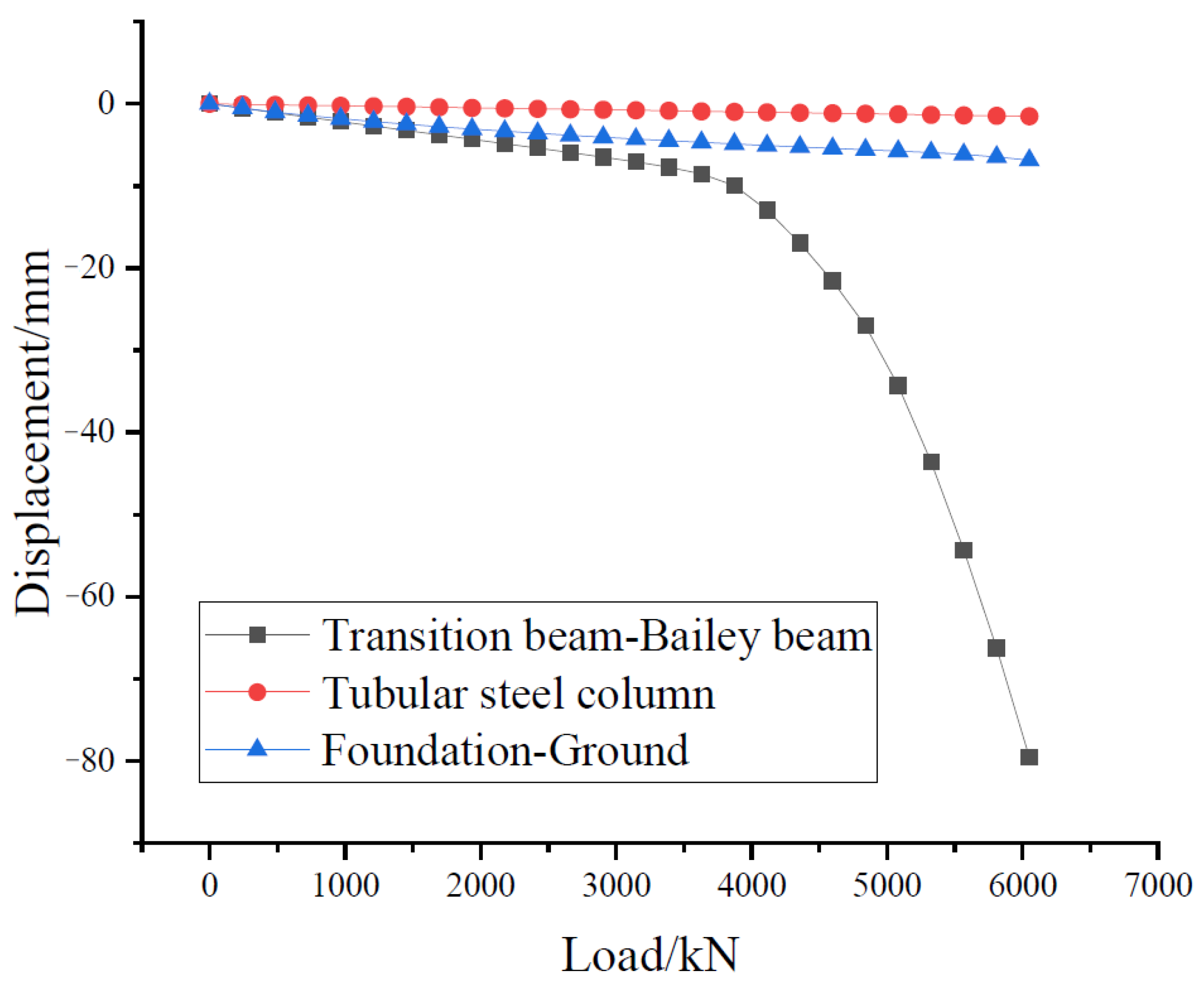
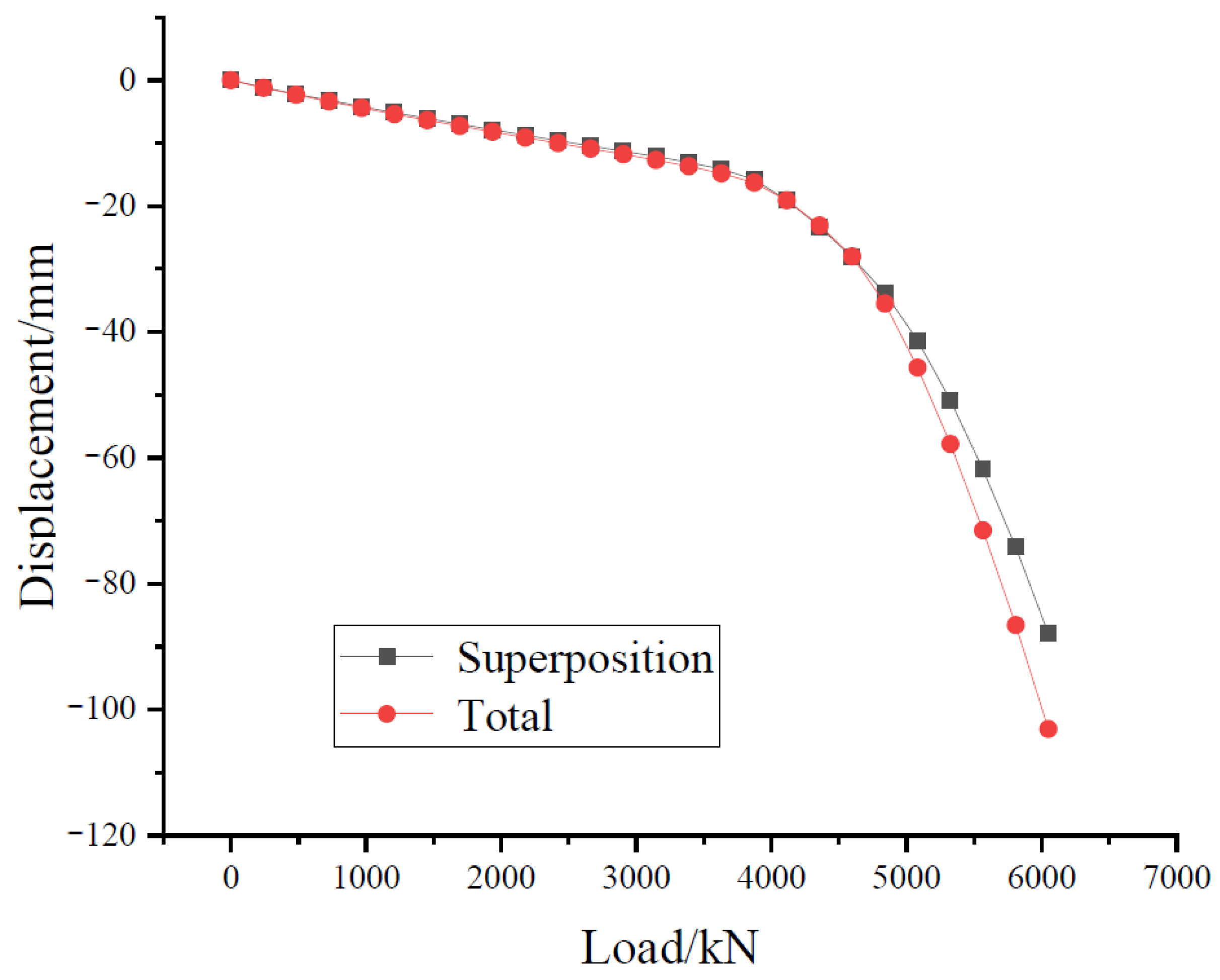


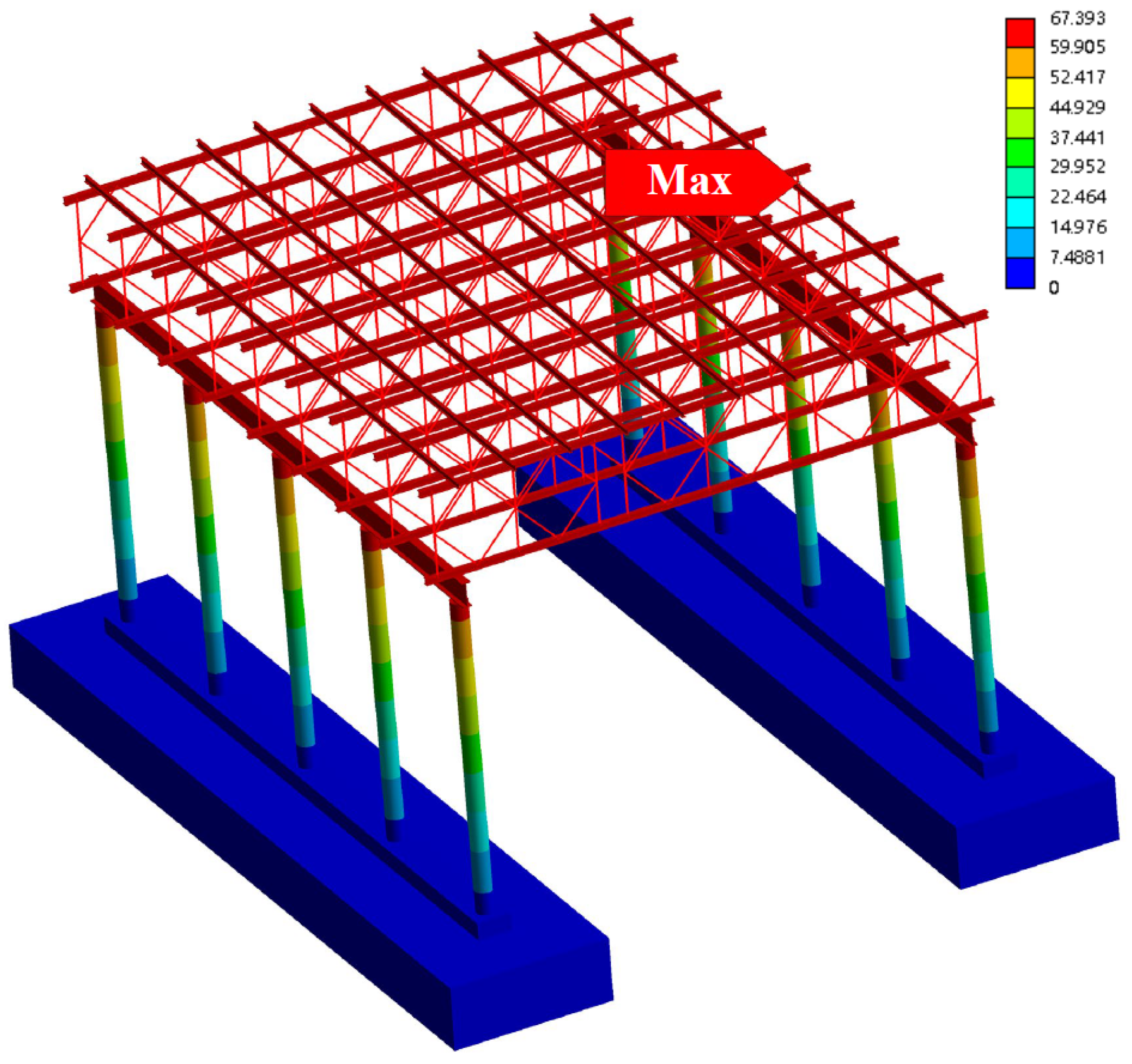
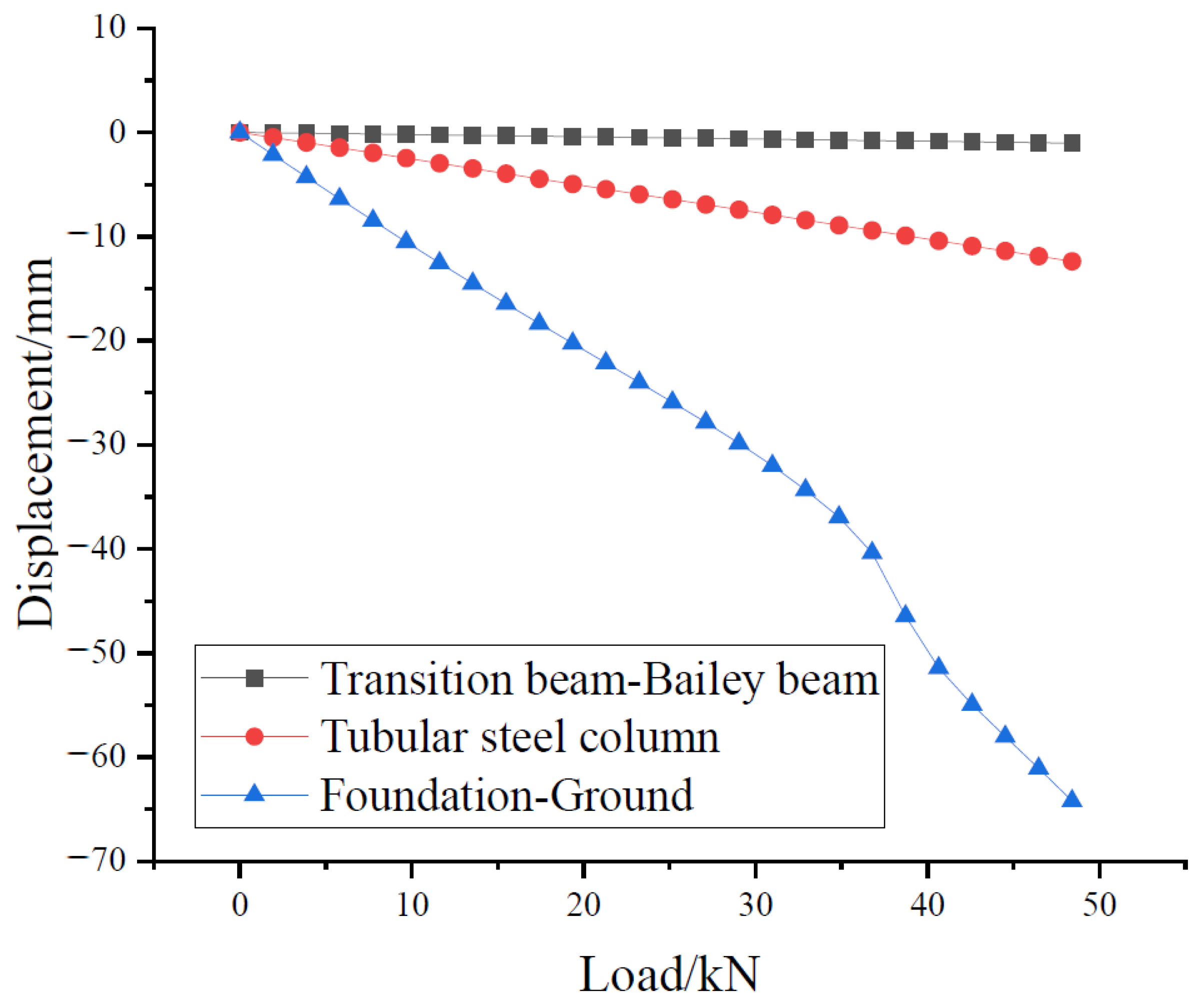
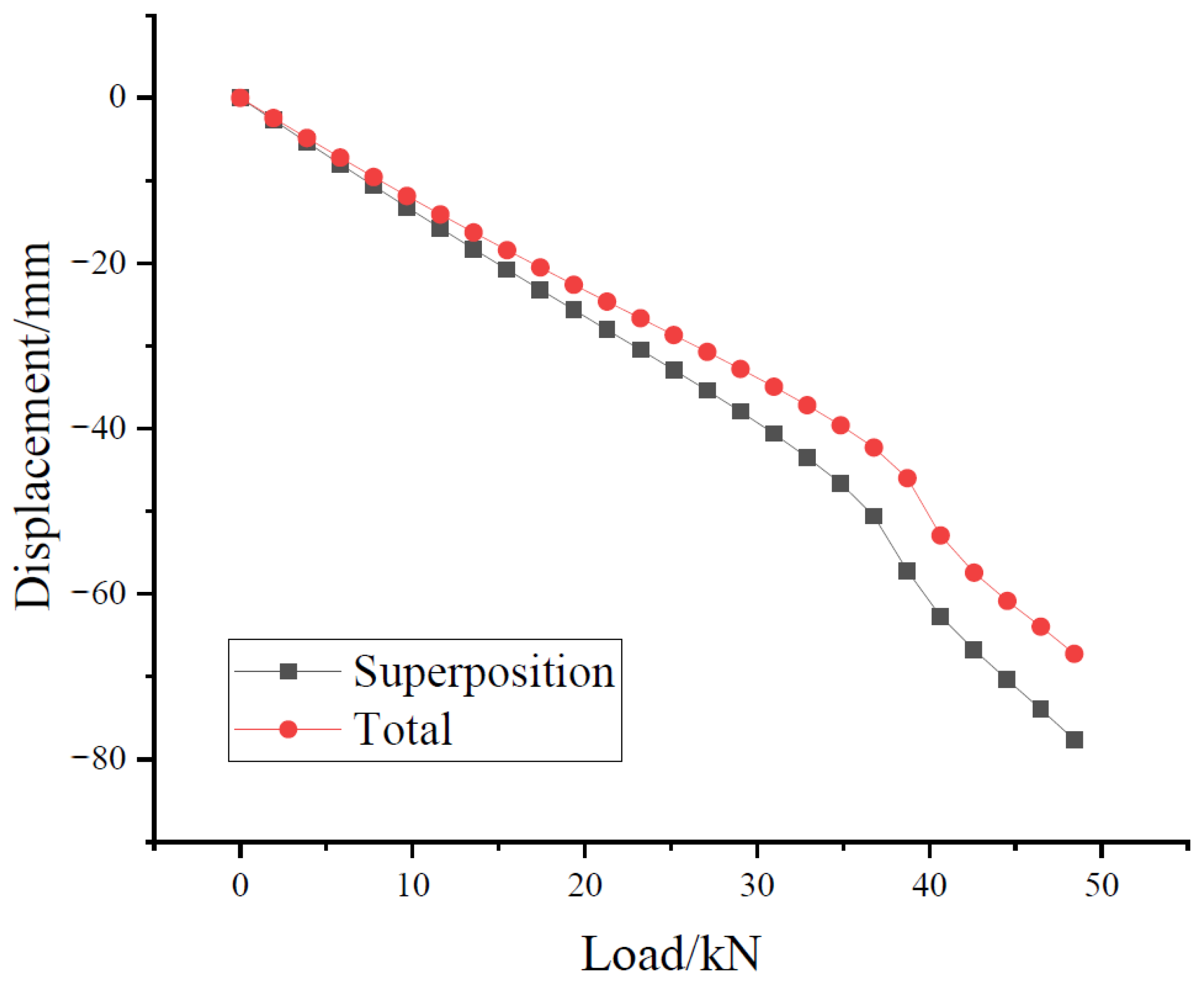
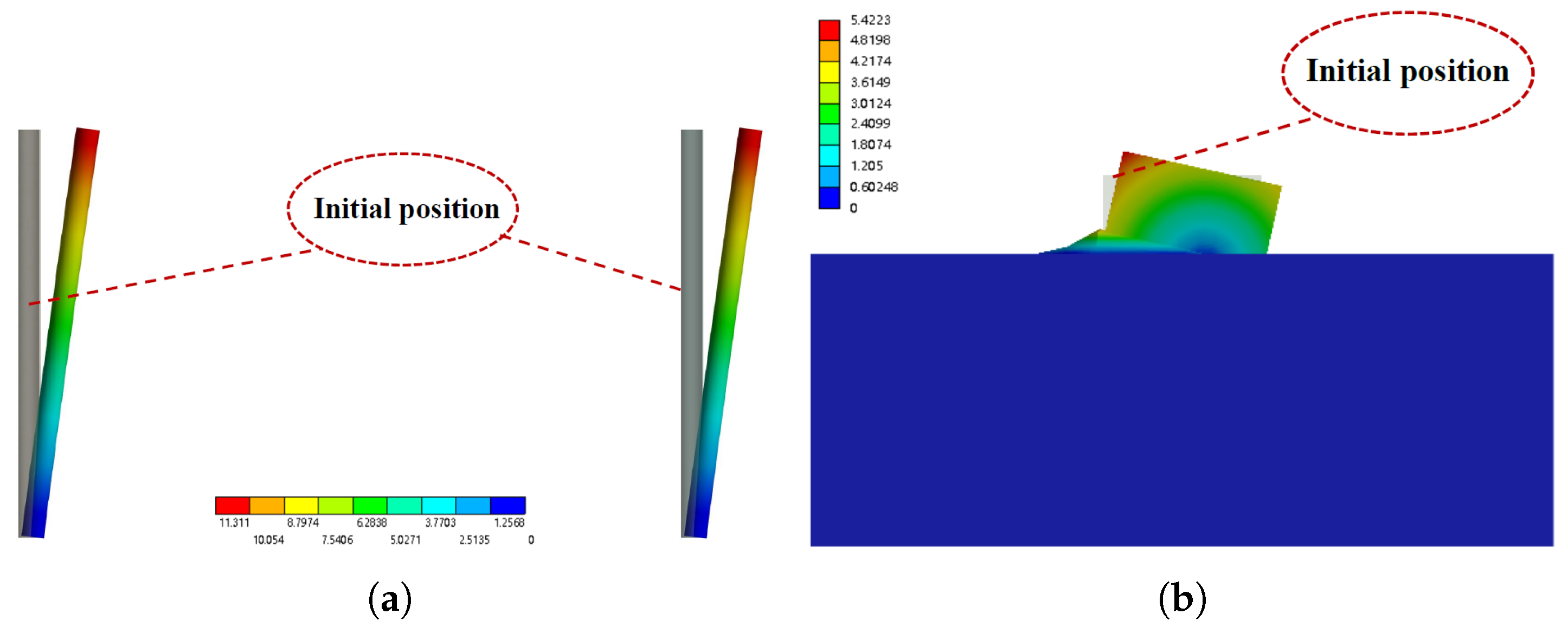
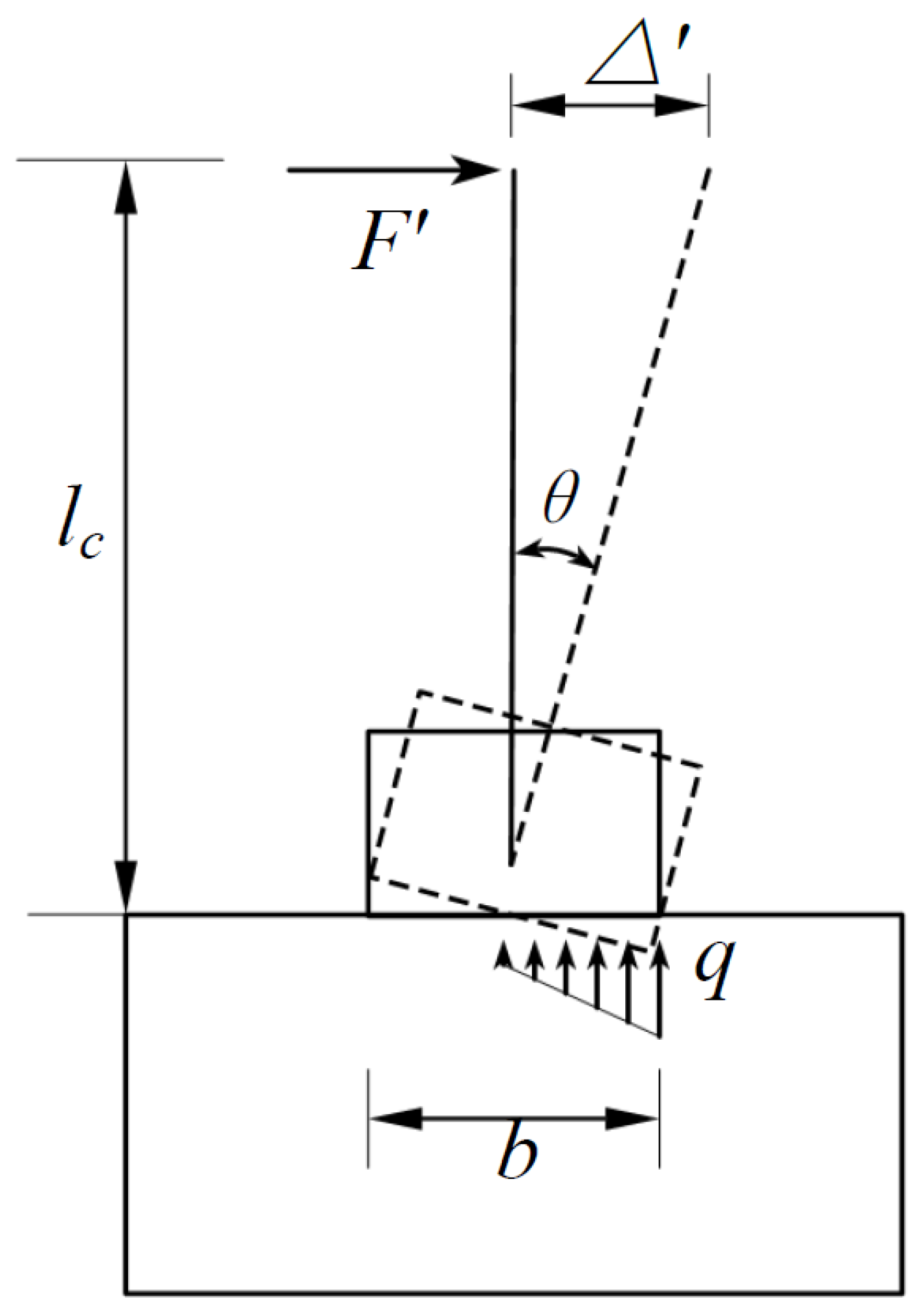
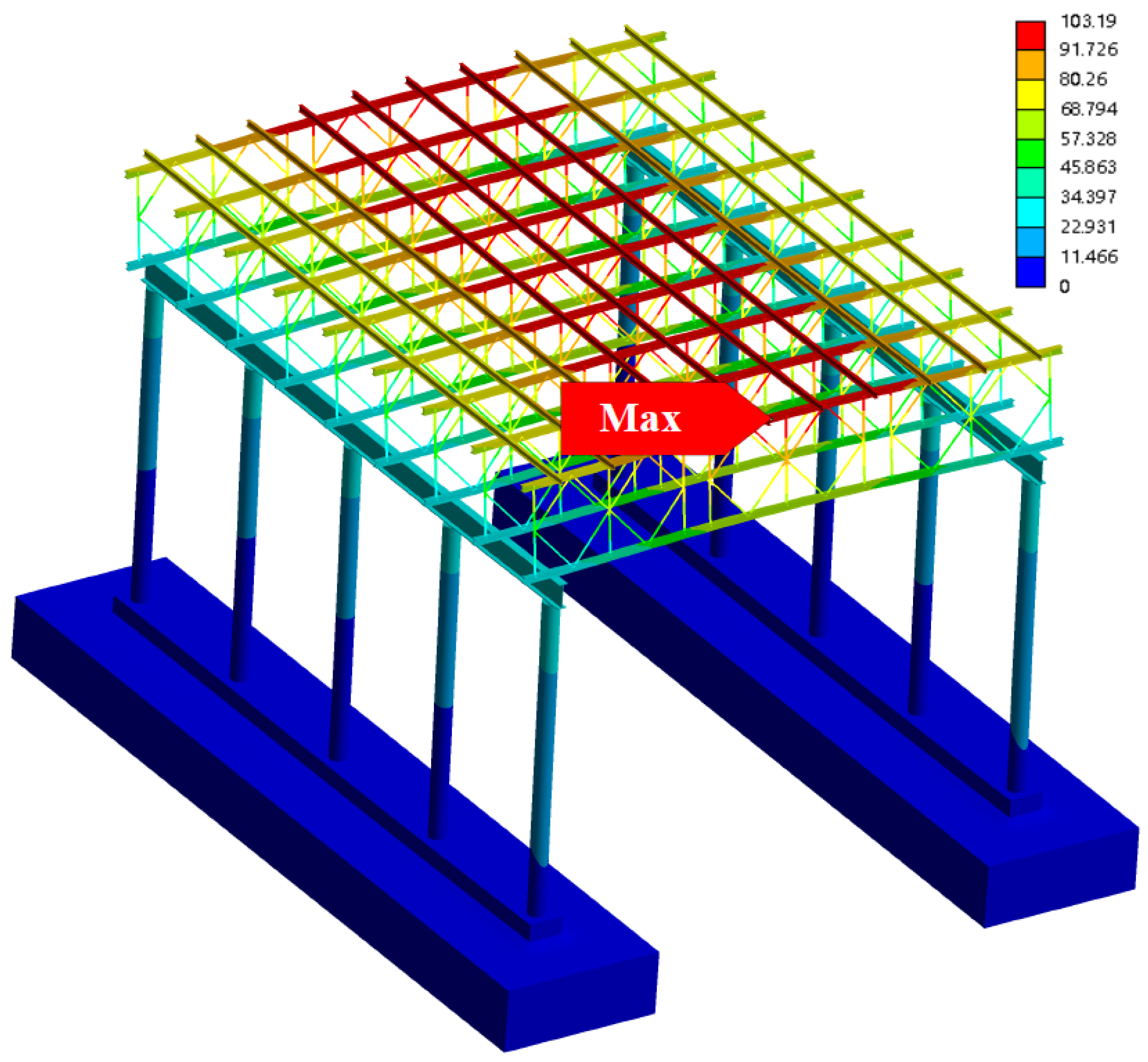
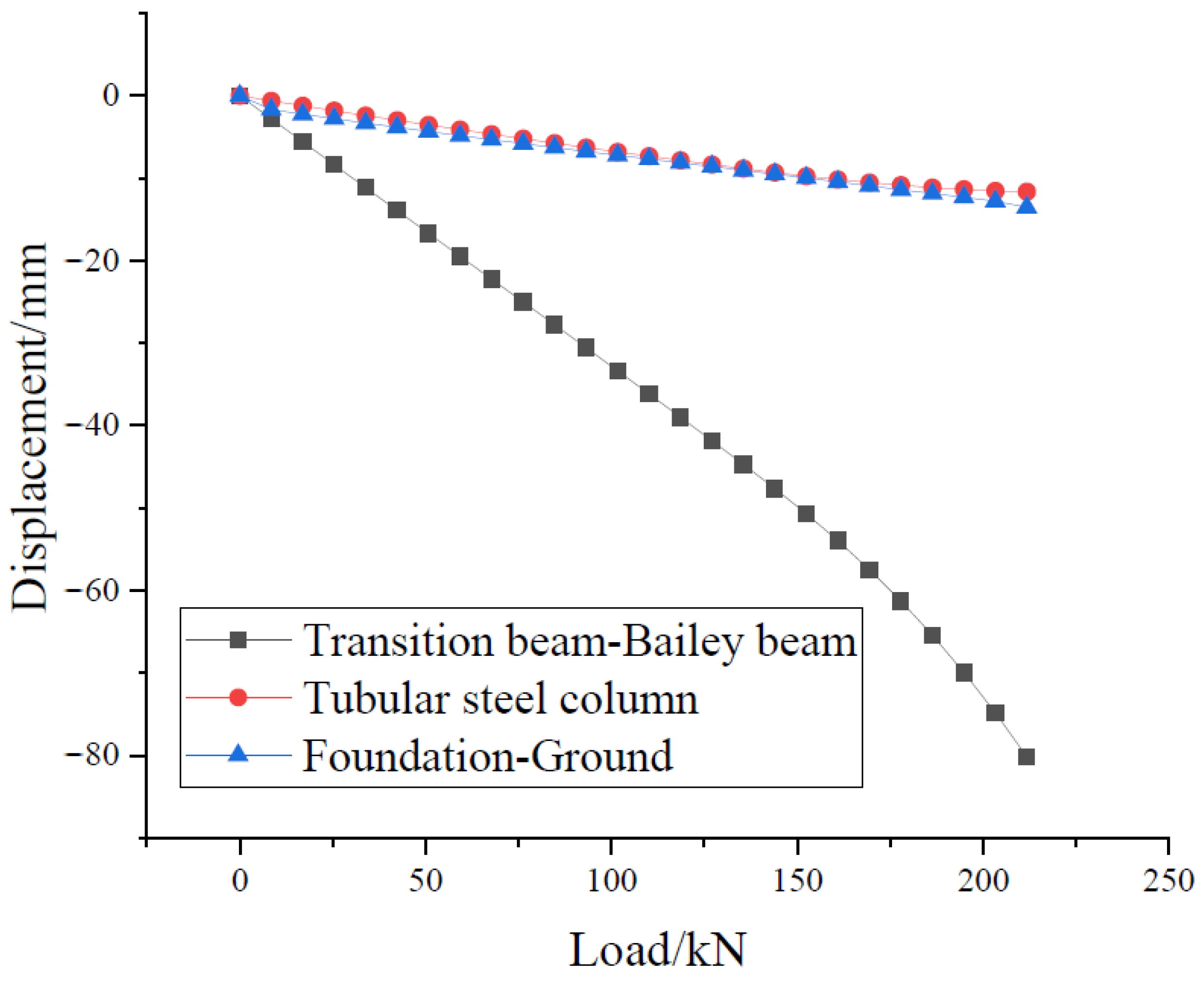

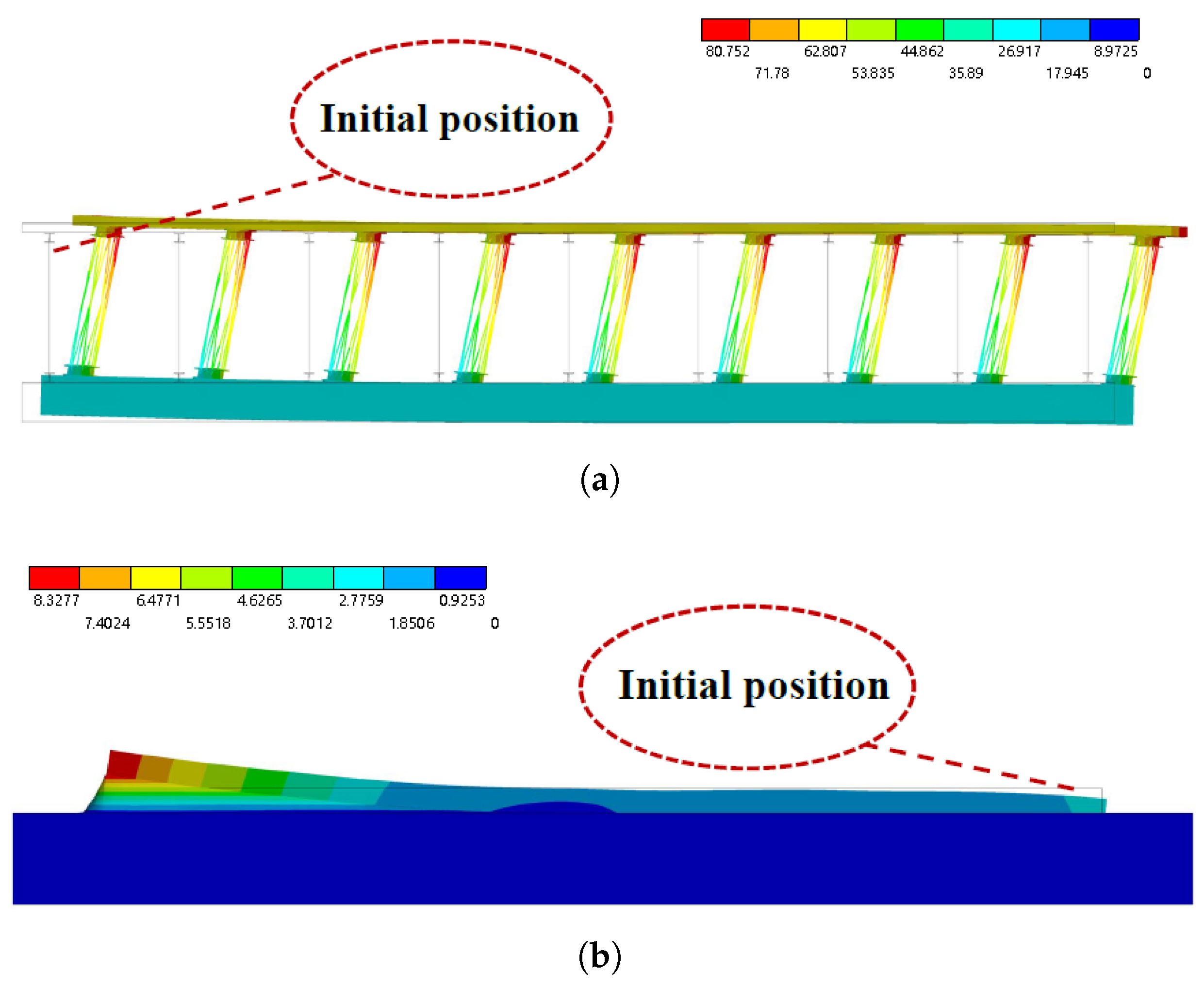
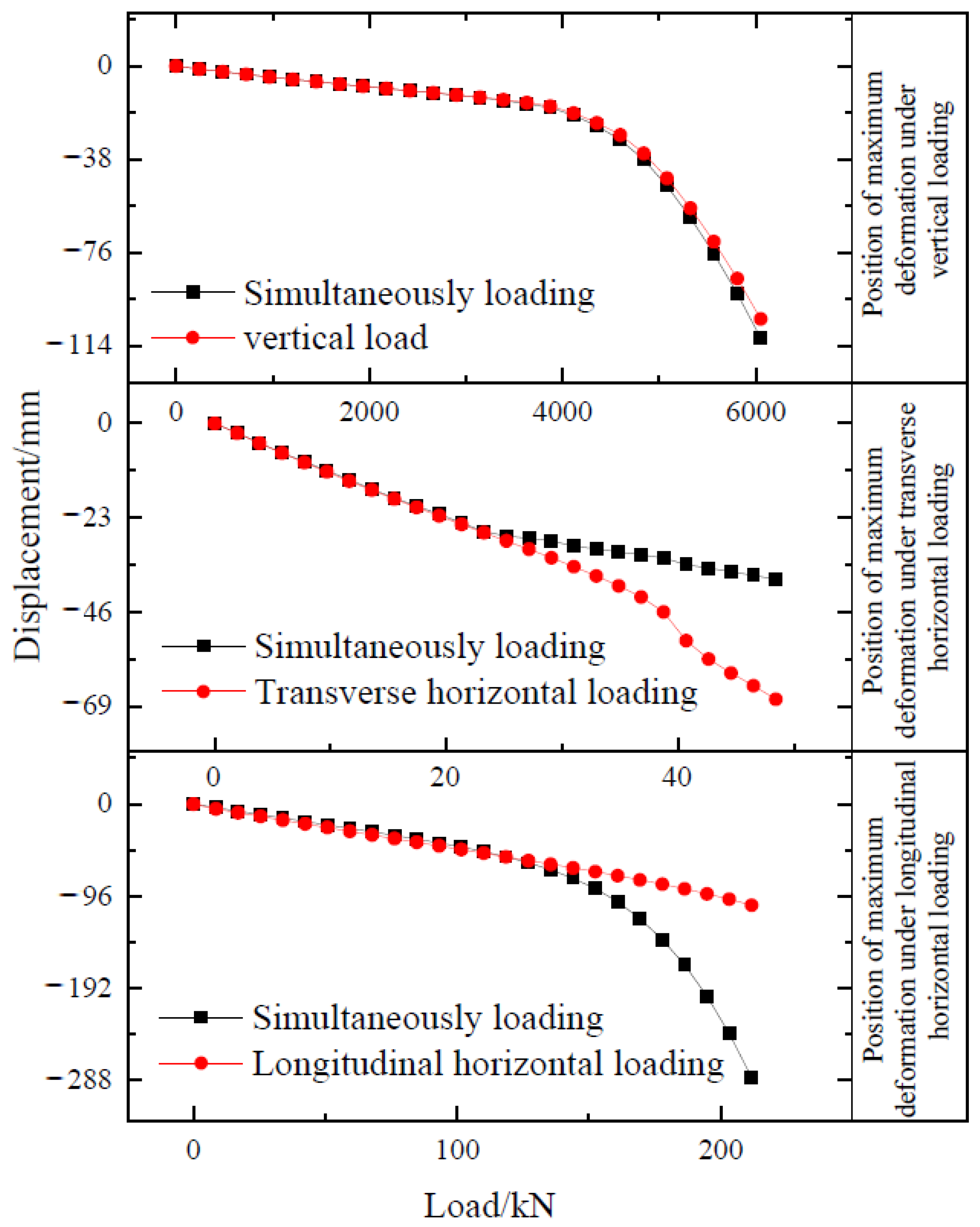
| Name | Section Type | Material | Modulus of Elasticity (N/mm) | Poisson’s Ratio | Density (kg/m) |
|---|---|---|---|---|---|
| Transition beams | 12 I-beams | Q235 | 2.0 × 10 | 0.3 | 7850 |
| Bailey beams | 321 Bailey beams | Q235 | 2.0 × 10 | 0.3 | 7850 |
| Load-bearing beams | 40a I-beams | Q235 | 2.0 × 10 | 0.3 | 7850 |
| Tubular steel columns | 273 mm × 8 mm | Q235 | 2.0 × 10 | 0.3 | 7850 |
| Foundation | - | C25 | 2.8 × 10 | 0.2 | 2300 |
| Ground | - | loess | 1.07 × 10 | 0.35 | 1800 |
Disclaimer/Publisher’s Note: The statements, opinions and data contained in all publications are solely those of the individual author(s) and contributor(s) and not of MDPI and/or the editor(s). MDPI and/or the editor(s) disclaim responsibility for any injury to people or property resulting from any ideas, methods, instructions or products referred to in the content. |
© 2023 by the authors. Licensee MDPI, Basel, Switzerland. This article is an open access article distributed under the terms and conditions of the Creative Commons Attribution (CC BY) license (https://creativecommons.org/licenses/by/4.0/).
Share and Cite
Wang, W.; Yang, Z.; Guo, C.; Lu, C.; Cheng, S. Deformation Analysis and Optimization of Steel-Tube-Columns Combined-with-Bailey-Beams Doorway Support. Buildings 2023, 13, 2541. https://doi.org/10.3390/buildings13102541
Wang W, Yang Z, Guo C, Lu C, Cheng S. Deformation Analysis and Optimization of Steel-Tube-Columns Combined-with-Bailey-Beams Doorway Support. Buildings. 2023; 13(10):2541. https://doi.org/10.3390/buildings13102541
Chicago/Turabian StyleWang, Weimin, Zheng Yang, Chen Guo, Chunting Lu, and Shengzhao Cheng. 2023. "Deformation Analysis and Optimization of Steel-Tube-Columns Combined-with-Bailey-Beams Doorway Support" Buildings 13, no. 10: 2541. https://doi.org/10.3390/buildings13102541




